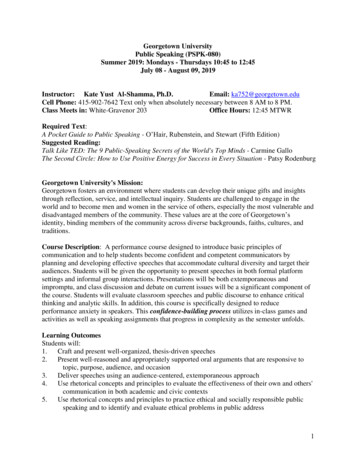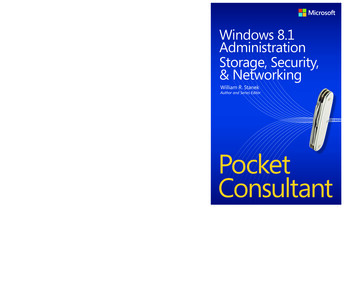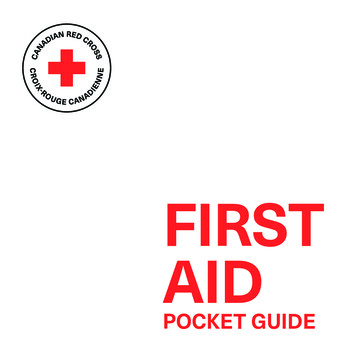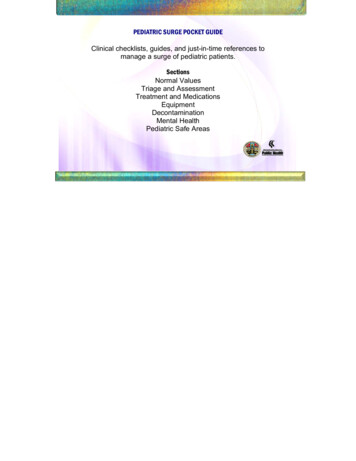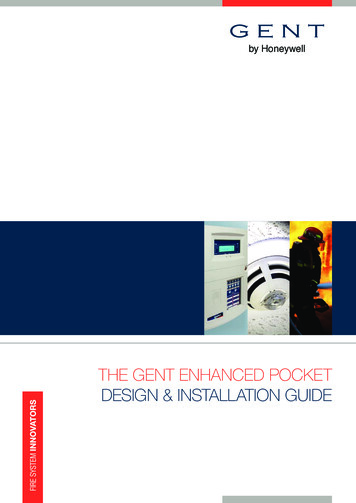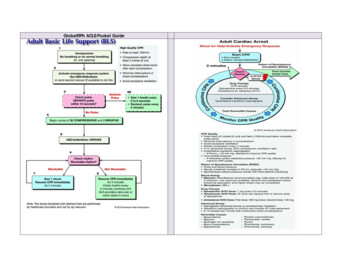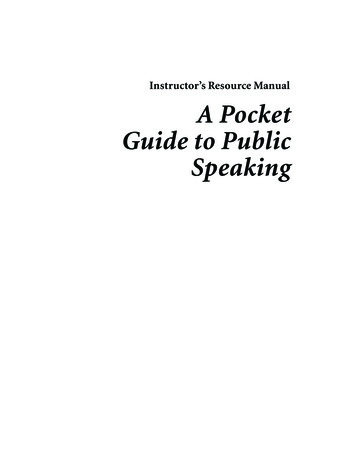
Transcription
Instructor’s Resource ManualA PocketGuide to PublicSpeaking
Instructor’s Resource ManualA PocketGuide to PublicSpeakingSecond EditionDan O’HairHannah RubensteinRob StewartPrepared byElaine Wittenberg-LylesUniversity of Texas at San AntonioMelinda M. VillagranUniversity of Texas at San AntonioBEDFORD/ ST. MARTIN’SBoston New York
Copyright 2007 by Bedford/St. MartinsAll rights reserved.Instructors who have adopted A Pocket Guide to Public Speaking, Second Edition, as a textbook for acourse are authorized to duplicate portions of this manual for their students.Manufactured in the United States of America.1 0 9 8 7f e d c b aFor information, write: Bedford/St. Martin’s, 75 Arlington Street, Boston, MA 02116(617-399-4000)ISBN-10: 0-312-45210-1ISBN-13: 978-0-312-45210-0Acknowledgments“Late Night Reflections of a College President: A Virtual University,” by Nancy S. Dye. Published in VitalSpeeches of the Day, Vol. LXIII, No. 24, October 1, 1997. Reprinted by permission of City News PublishingCo., Inc.“Testimony against Legalized Gambling before the U.S. House Judiciary Committee,” by Reverend TomGrey, former executive director of the National Coalition against Legalized Gambling (NCALG).Delivered on September 29, 1995. Reprinted by permission of Tom Grey.“Free the Children,” address by Craig Kielburger, founder, Free the Children, www.freethechildren.com.Delivered before the U.S. Congressional Subcommittee on International Relations and Human Rights,June 11, 1996. Reprinted by permission of Craig Kielburger.“Teach for America,” commencement address by Wendy Kopp. Delivered at Drew University, May 20,1995. Reprinted with permission of Wendy Kopp, president and founder of Teach for America.“Eulogy for Princess Diana,” by Earl Spencer. Reprinted by The New York Times, September 6, 1998.Copyright 1998 by The New York Times Company. Reprinted with permission.
PREFACEINTRODUCTIONThis Instructor’s Resource Manual to accompany Dan O’Hair, Hannah Rubenstein, and Rob Stewart’s A Pocket Guide to Public Speaking, Second Edition, is avaluable tool for new and experienced instructors alike. For first-time instructorsin the public speaking classroom, this comprehensive manual provides directionin defining a pedagogical stance and constructing related teaching strategies, andin planning and organizing a public speaking course. For experienced instructorsin the public speaking classroom, the manual offers creative and innovative advicefor incorporating variety into teaching methods and activities. And for instructorsin any academic discipline, the manual gives concrete guidance in incorporatingoral presentations into a range of college classes — the social sciences, humanities,education, business, science, and engineering. For all instructors, it provides aframework for the course and for teaching the content of the text. Although thisInstructor’s Resource Manual is comprehensive in terms of content, many of theinterpretations, analyses, and activities are simply basic guidelines or suggestions;thus instructors are encouraged to adapt exercises and discussions to their ownteaching styles and strengths, as well as to each classroom’s climate and culture.A Pocket Guide to Public Speaking, Second Edition, has been designed withtoday’s busy student in mind, providing the tools students need to prepare and deliver a wide range of speeches, all in a brief format. Commensurate with the spiritof the text, the Instructor’s Resource Manual is designed to help instructors facilitate student learning. Just as students must develop the knowledge and skills thatwill allow them to become effective public speakers, the philosophy of this manualis that instructors must acquire the knowledge and skills necessary to become effective teachers. Honing the skills most appropriate to achieving learning goals willinvolve commitment, critical thinking, adaptation and change, and a willingnessto engage in a dialogue with students.ORGANIZATION AND HIGHLIGHTS OF THE MANUALThe Instructor’s Resource Manual begins with a section on course managementthat offers general suggestions and advice for instructors of the public speakingcourse as well as any other course that includes public speaking elements. Part 2narrows the focus to organizing and structuring a public speaking course, as well asincorporating public speaking content into courses across the curriculum. Part 3then provides a chapter-by-chapter analysis of the content of A Pocket Guide toPublic Speaking, Second Edition, as well as specific suggestions for teaching coursev
viPREFACEmaterial on each chapter’s topics. Part 4 provides additional resources for teachersand students, and Part 5 contains sample speeches for analysis and discussion.In Part 1, Course Management, instructors will find advice on defining apedagogical stance and formulating a teaching philosophy as well as suggestionsfor setting and achieving student learning goals. Recommendations for runningthe classroom include handling grade complaints and dealing with confrontations;soliciting feedback from students; encouraging and using communication outsidethe classroom; and giving tests, grading speeches, and evaluating assignments. Inaddition, several teaching strategies — involving role playing, games, field trips,classroom guests, computer-mediated communication, brainstorming, homework, goal setting, and student empowerment — are described and analyzed. Part 1discusses incorporating films and videos, classroom ethics, and plagiarism. It alsoaddresses special student considerations, such as culture and gender, English as asecond language, students with disabilities, and nontraditional students. New tothis edition is a section offering tips for beginning instructors as well as advice forinstructors using A Pocket Guide to Public Speaking, Second Edition, for the firsttime. This section includes helpful descriptions of the resources available withPocket, advice for classroom discipline, and key FAQs covering common concernsof first-time instructors. At the end of Part 1, a section titled “Using the PocketGuide in Other Courses” gives advice to instructors who are incorporating publicspeaking into their courses for the first time.Part 2, Organizing and Structuring a Public Speaking Course, includes detailedsample course syllabi and schedules. Other highlights of this section are samplespeech assignments, guidelines, and grading sheets for use by both instructors andstudents in evaluating speeches, a discussion on incorporating technology intopublic-speaking assignments, and suggested activities using PowerPoint technology. The section titled “What to Focus on When Time Is Limited” is designed tohelp instructors in other disciplines integrate public speaking into their classes. Itincludes suggested courses of study for one- or three-week units on public speaking, along with a brief speech grading sheet that helps instructors evaluate studentpresentations in classes across the curriculum.Part 3, Chapter-by-Chapter Analysis, highlights the major components of APocket Guide to Public Speaking, Second Edition. For each chapter, a chapter content outline is provided, and all key terms are defined. Class discussion questionsand content presentation ideas are provided, along with numerous activities andexercises to reinforce students’ understanding of the material.GENERAL SUGGESTION FOR USING THE MANUALThis Instructor’s Resource Manual includes all the materials an instructor needs tostructure the course, present the material in the text, and facilitate students’ cognitive and experiential learning. Nevertheless, instructors should use these materialsin a way that best suits the goals they have set for the course and to encourage students’ effective learning. Based on the level of teaching experience, each instructorwill find different aspects of the manual helpful. Hopefully, the manual will maketeaching the course more enjoyable and rewarding for instructors and learning thematerial more satisfying for students.
PREFACEIn using the manual, the instructor must adapt the assignments and activitiesto the particulars of each class. To do this, the instructor must consider such issuesas time constraints, number of students, academic background of the students,class climate, and individual teaching style. What works well for an instructor inone class may not necessarily suffice for another.Generally, we suggest that instructors examine the first two parts of the manualbefore the first day of class. Considering beforehand your own positions as well ashow you anticipate handling any problems that might arise during the semesterwill best prepare you to respond to the collective needs of your students and ensure a smoothly run, productive class. In all likelihood, you will encounter issuesthat will cause you to rethink your stance or the way in which you have structuredthe class and the course. Use the syllabi and schedules provided, but understandtheir tentativeness; you may have to add to, change, or eliminate portions to accommodate your goals or the students’ needs. In effect, Parts 1 and 2 of the Instructor’s Resource Manual are simply a compendium of general advice, alongwith some specific guidelines for instructors of other courses who are pressed fortime yet need to incorporate public speaking into their syllabi.Before using Parts 3 and 4 of the Instructor’s Resource Manual, we suggest youfirst read the text of A Pocket Guide to Public Speaking, Second Edition, so that yougain the perspective of the student who is encountering the material for the firsttime. The detailed content outlines and summaries provided incorporate all of themajor points of the text; however, the nuances of the material may have been lostin the synthesis. These two parts of the manual parallel the presentation of materials in the text and should be used to structure the analysis and discussion of eachchapter. Should you choose to involve students in presenting chapter information,this material will help you evaluate the depth and breadth of their presentations,as well as indicate the areas you should elaborate on, illustrate, or explain in greaterdetail. The activities, exercises, and suggested supplementary materials includedhere will allow you to more effectively target, apply, and extend specific topics, andto help students gain the skills needed to become effective public speakers.ACKNOWLEDGMENTSThe second edition of this manual was developed by Susan Gouijnstook, a freelanceeditor whose extensive editorial experience has enabled her to carefully update thisbook to better serve instructors. Her thorough revisions expanded upon the workdone on the first edition by Elaine Wittenberg-Lyles, an assistant professor in interpersonal communication at the University of Texas at San Antonio, who createdthis manual by using material from the Instructor’s Resource Manual for O’Hair,Stewart, and Rubenstein’s A Speaker’s Guidebook.This Instructor’s Resource Manual is a compilation of five years of MelindaVillagran’s experience as a graduate teaching assistant and basic course director atthe University of Oklahoma and Southwest Texas State University. She is currentlyan assistant professor at the University of Texas at San Antonio. She would like toacknowledge her fellow directors of basic courses for their contributions to thismanual: Lisa Sparks Bethea, Tara Crowell, Teresa Bridges, Julianne Scholl, TerryRobertson, and April Franklin.vii
viiiPREFACEBecause of the brief nature of A Pocket Guide to Public Speaking, Second Edition, Dan O’Hair, Hannah Rubenstein, and Rob Stewart were unable to thank themany thoughtful reviewers who contributed input and ideas during the development of the book: William Banks, Ferris State University; Kimberly Batty-Herbet,Broward Community College North; Doug Bennett, Northwest Mississippi Community College; Nate Brown, Santa Monica College; Edward Coursey, Palm BeachCommunity College; Ken Cox, Florence-Darlington Technical College; DonnaCraine, Front Range Community College; Greg Guelcher, Morningside College;Richard Harmon, Seminole Community College; Deborah Kraut, Santa MonicaCollege; Peter Lee, California State University, Fullerton; John Mandes, Collegeof the Desert; P. Wynn Norman, Lenoir Community College; Steve Schwarze,University of Montana; Andree Swanson, Community College of Aurora; MaryTrachsel, University of Iowa; Steve Vrooman, Texas Lutheran University; and TrentWebb, Nassau Community College.
CONTENTSPreface1vCourse Management1Formulating a Teaching Philosophy1Setting and Achieving Student Learning Goals1General Suggestions for Running the Classroom2Handling Grade Complaints and Dealing with Confrontations3Lecturing and Facilitating Group Discussion3Encouraging and Using Communication Outside the Classroom4Test Giving, Evaluations, Grading Speeches, and Assignments5Teaching Strategies6Role Playing and Games6Field Trips and Classroom Guests7Computer-Mediated CommunicationBrainstorming7Homework87Incorporating Outside Sources and MaterialsSelecting Films and Videos88Ethics9Soliciting Feedback from StudentsSpecial Considerations1010Culture and Gender Considerations10ESL (English as a Second Language) Students10Accommodating Students with Disabilities11Including Nontraditional Students11Tips for First-Time Instructors11Advice for Using A Pocket Guide to Public Speaking, Second Edition,for the First Time12Print Resources12Media Resources13The First Day13Learning Styles14Visual Learners14Auditory Leaners14Tactile/Kinesthetic LearnersParticipation15Nonverbal Behavior15Verbal Behavior1514ix
xCONTENTSFeedback16Discipline16Dealing with Difficult Students16Student Intimidation17Inappropriate Student Comments18Service Learning in Public Speaking 18Definition of Service Learning18Benefits of Service Learning18Service Learning Projects19Grading Service Learning Projects19FAQ20Using the Pocket Guide in Other Courses23Incorporating Public Speaking into Your Course223Organizing and Structuring a Public Speaking CourseSample Syllabus2525PUBLIC SPEAKING SYLLABUS26STUDENT’S RECORD OF GRADES29INFORMATION SHEET FOR INSTRUCTOR 30Sample Course SchedulesSEMESTER SCHEDULE 31QUARTER SCHEDULE 33SUMMER SESSION SCHEDULE3135Descriptions of Speech Assignments37DESCRIPTION FOR SPEECH 1: CEREMONIAL SPEECH 38OUTLINE WORKSHEET FOR CEREMONIAL SPEECH 1 39DESCRIPTION FOR SPEECH 2: ORGANIZING AND OUTLINING THE INFORMATIVE SPEECH 40OUTLINE WORKSHEET FOR INFORMATIVE SPEECH 2 41DESCRIPTION FOR THE INFORMATIVE COMMUNICATION RESEARCH PAPER 43INFORMATIVE COMMUNICATION RESEARCH PAPER REQUIREMENTS 44DESCRIPTION FOR SPEECH 3: ORGANIZING AND OUTLINING THE PERSUASIVE SPEECH—ACTIONOUTLINE WORKSHEET FOR MONROE’S MOTIVATED SEQUENCE: PERSUASIVE SPEECH 3 46GROUP PRESENTATION OPTION 1: A PROFESSIONAL PRESENTATION—LEARNING48TO USE POWERPOINTDESCRIPTION OF POWERPOINT ASSIGNMENT49OUTLINE WORKSHEET FOR GROUP PRESENTATION OPTION 1 50GROUP PRESENTATION OPTION 2: INTRODUCTION TO DEBATE AND ARGUMENTATION52ORGANIZING AND OUTLINING THE PERSUASIVE DEBATE 64STEPS FOR BUILDING A DEBATE/DEBATE JOB DESCRIPTIONS 65OUTLINE WORKSHEET FOR GROUP PRESENTATION OPTION 2 66Sample Student Outlines68SAMPLE OUTLINE FOR CEREMONIAL SPEECH 1 68SAMPLE OUTLINE FOR INFORMATIVE SPEECH 2 70SAMPLE INFORMATIVE COMMUNICATION RESEARCH PAPER:THE MICROBREWING WORLDSAMPLE OUTLINE FOR MONROE’S MOTIVATED SEQUENCE: PERSUASIVE SPEECH 3 75SAMPLE OUTLINE FOR GROUP PRESENTATION OPTION 1 787345
CONTENTSGuidelines and Suggestions for Evaluating Student SpeechesEvaluating Online Sources82Speech Evaluation Sheets83GRADING SHEET FOR SPEECH 1: CEREMONIAL SPEECH 84GRADING SHEET FOR SPEECH 2: INFORMATIVE SPEECH 85GRADING SHEET FOR SPEECH 3: PERSUASIVE SPEECH PROPOSING ACTIONGRADING CRITERIA FOR POWERPOINT ACTIVITY 89GRADING SHEET FOR PERSUASIVE DEBATE 90GRADING SHEET FOR PROFESSIONAL PRESENTATION 91DESCRIPTION AND GRADING SHEET FOR TEAM WORKSHOP92GRADING SHEET FOR TEAM WORKSHOP93SELF-EVALUATION VIDEO SHEET 94PEER EVALUATION SHEET 95OUTSIDE SPEECH CRITIQUE EVALUATION 1 96OUTSIDE SPEECH CRITIQUE EVALUATION 2 97What to Focus on When Time Is LimitedGrading and Evaluating Speeches98SAMPLE GRADE SHEET381879899Chapter-by-Chapter Analysis101CHAPTER 1 BECOMING A PUBLIC SPEAKER103Chapter Content Outline103Key Terms104Chapter Study Guide106Content Presentation Ideas108Recommended Supplementary Resources119CHAPTER 2 ETHICAL PUBLIC SPEAKING120Chapter Content Outline120Key Terms121Chapter Study Guide122Content Presentation Ideas125Recommended Supplementary Resources132CHAPTER 3 LISTENERS AND SPEAKERSChapter Content Outline133Key Terms134Chapter Study Guide135Content Presentation Ideas136Recommended Supplementary ResourcesCHAPTER 4 TYPES OF SPEECHESChapter Content Outline146Key Terms146133145146CHAPTER 5 FROM A TO Z: OVERVIEW OF A SPEECHChapter Content Outline147Chapter Study Guide147147xi
xiiCONTENTSContent Presentation Ideas148Recommended Supplementary Resources153CHAPTER 6 MANAGING SPEECH ANXIETY154Chapter Content Outline154Key Terms155Chapter Study Guide155Content Presentation Ideas157Recommended Supplementary Resources161CHAPTER 7 ANALYZING THE AUDIENCE162Chapter Content Outline162Key Terms165Chapter Study Guide166Content Presentation Ideas167Recommended Supplementary Resources175CHAPTER 8 SELECTING A TOPIC AND PURPOSEChapter Content Outline176Key Terms177Chapter Study Guide177Content Presentation Ideas179Recommended Supplementary Resources188CHAPTER 9 DEVELOPING SUPPORTING MATERIALChapter Content Outline189Key Terms190Chapter Study Guide191Content Presentation Ideas192Recommended Supplementary Resources197CHAPTER 10 LOCATING SUPPORTING MATERIALChapter Content Outline198Key Terms199Chapter Study Guide199Content Presentation Ideas200Recommended Supplementary Resources208176189198CHAPTER 11 DOING EFFECTIVE INTERNET RESEARCHChapter Content Outline209Key Terms211Chapter Study Guide212Content Presentation Ideas212Recommended Supplementary Resources217CHAPTER 12 ORGANIZING THE SPEECHChapter Content Outline218Key Terms219Chapter Study Guide220Content Presentation Ideas221218209
CONTENTSRecommended Supplementary Resources227CHAPTER 13 SELECTING AN ORGANIZATIONAL PATTERNChapter Content Outline228Key Terms228Chapter Study Guide229Content Presentation Ideas230Recommended Supplementary Resources234CHAPTER 14 OUTLINING THE SPEECHChapter Content Outline235Key Terms236Chapter Study Guide236Content Presentation Ideas237Recommended Supplementary Resources235241CHAPTER 15 DEVELOPING THE INTRODUCTION ANDCONCLUSION242Chapter Content Outline242Key Terms243Chapter Study Guide244Content Presentation Ideas245Recommended Supplementary Resources256CHAPTER 16 USING LANGUAGE257Chapter Content Outline257Key Terms259Chapter Study Guide259Content Presentation Ideas261Recommended Supplementary Resources275CHAPTER 17 CHOOSING A METHOD OF DELIVERYChapter Content Outline276Key Terms277Chapter Study Guide277Content Presentation Ideas278Recommended Supplementary Resources281CHAPTER 18 CONTROLLING THE VOICE282Chapter Content Outline282Key Terms283Chapter Study Guide284Content Presentation Ideas285Recommended Supplementary Resources289CHAPTER 19 USING THE BODY290Chapter Content Outline290Key Terms291Chapter Study Guide291Content Presentation Ideas292276228xiii
xivCONTENTSRecommended Supplementary Resources295CHAPTER 20 TYPES OF PRESENTATION AIDSChapter Content Outline296Key Terms297Chapter Study Guide298Content Presentation Ideas299Recommended Supplementary Resources305296CHAPTER 21 DESIGNING PRESENTATION AIDSChapter Content Outline306Key Terms307Chapter Study Guide307Content Presentation Ideas308Recommended Supplementary Resources312306CHAPTER 22 A BRIEF GUIDE TO MICROSOFT POWERPOINTChapter Content Outline313Key Terms314Chapter Study Guide314Content Presentation Ideas314Recommended Supplementary Resources318CHAPTER 23 INFORMATIVE SPEAKINGChapter Content Outline319Key Terms320Chapter Study Guide321Content Presentation Ideas322Recommended Supplementary Resources313319329CHAPTER 24 PERSUASIVE SPEAKING330Chapter Content Outline330Key Terms334Chapter Study Guide335Content Presentation Ideas338Recommended Supplementary Resources346CHAPTER 25 SPEAKING ON SPECIAL OCCASIONSChapter Content Outline348Key Terms349Chapter Study Guide350Content Presentation Ideas351Recommended Supplementary Resources359348CHAPTER 26 TYPICAL CLASSROOM PRESENTATION FORMATSChapter Content Outline360Key Terms361Chapter Study Guide361Content Presentation Ideas362360
CONTENTSCHAPTER 27 SCIENCE AND MATHEMATICS COURSESChapter Content Outline365Key Terms365Chapter Study Guide366Content Presentation Ideas367CHAPTER 28 TECHNICAL COURSESChapter Content Outline370Key Terms370Chapter Study Guide371Content Presentation Ideas371370CHAPTER 29 SOCIAL SCIENCE COURSESChapter Content Outline375Key Terms376Chapter Study Guide376Content Presentation Ideas376375CHAPTER 30 ARTS AND HUMANITIES COURSESChapter Content Outline381Chapter Study Guide381Content Presentation Ideas382CHAPTER 31 EDUCATION COURSESChapter Content Outline385Key Terms385Chapter Study Guide385Content Presentation Ideas386CHAPTER 32 BUSINESS COURSESChapter Content Outline390Key Terms390Content Presentation Ideas390365381385390CHAPTER 33 NURSING AND ALLIED HEALTH COURSESChapter Content Outline393Key Terms394Content Presentation Ideas394CHAPTER 34 COMMUNICATING IN GROUPSChapter Content Outline396Key Terms397Chapter Study Guide398Content Presentation Ideas399Recommended Supplementary Resources407393396CHAPTER 35 BUSINESS AND PROFESSIONAL PRESENTATIONSChapter Content Outline408Key Terms409408xv
xviCONTENTSChapter Study Guide409Content Presentation Ideas409Recommended Supplementary Resources4412Additional Resources413Search Engines413Helpful Web Sites for Teachers and Students413Teaching with Videos414Ordering Educational Public Speaking Videos4155Sample Speeches for Analysis and Discussion417Craig Kielburger, “Free the Children Address before the U.S. CongressionalSubcommittee on International Relations and Human Rights”417Earl Spencer, “Eulogy for Princess Diana”421Wendy Kopp, “Commencement Address at Drew University”424Reverend Tom Grey, “Testimony against Legalized Gambling before the U.S.House Judiciary Committee”427Renzi Stone, “Live Longer and Healthier: Stop Eating Meat!”431Amber Mixon, “Making Dreams Reality”433President William Jefferson Clinton, “Address at the Time Magazine 75thAnniversary Celebration”436Nancy S. Dye, “Late-Night Reflections of a College President: A VirtualUniversity”440
Instructor’s Resource ManualA PocketGuide to PublicSpeaking
Part1CourseManagementFORMULATING A TEACHING PHILOSOPHYOne of the most important aspects of teaching is being able to formulate your ownteaching philosophy, which allows you to articulate your general and specific approaches toward instruction. A teaching philosophy is beneficial because it allowsyou to assess your strengths and limitations as an instructor. It also helps you realize your short-term and long-term pedagogical goals.A good, complete teaching philosophy includes several key issues. First, whatdo you believe are the most effective teaching methods? Using a lecture format?Engaging students in collaborative learning? Should students focus on theory orskills? What types of courses require you to emphasize one rather than the other?In addition, you should be able to formulate specific teaching goals, particularly asyou strive to improve your teaching methods.SETTING AND ACHIEVING STUDENT LEARNING GOALSStudents need to know why they are taking a course in public speaking. Providingthem with a rationale for the course may help them see how public speaking relatesto their chosen field of study. Most students have either a major or minor area ofstudy that requires public speaking; therefore, you can take the opportunity at thebeginning of the course to help them relate public speaking to their chosen or anticipated career. You may want to incorporate this approach into your course objectives, which would be listed in your syllabus.Just as you formulate objectives for yourself as the instructor, you should specify concrete course objectives in the course syllabus that you give to students. The1
2PART 1 Course Managementpurpose here is to specify for students what you expect them to learn. Studentsshould be aware of objectives specified for the overall course as well as for eachunit or chapter. Examples of learning objectives as stated on syllabi include “To enable students to command an audience’s attention” and “To present oneself as acompetent and credible speaker.”Finally, students should be made aware of the requirements for the course. Aswith many public speaking courses, a standard set of requirements exists that isusually applied to several sections of the course at a particular school. However,you may be responsible for setting the requirements yourself. If so, be sure to address the attendance policy, penalties for absences, required textbooks and othermaterials, number and format of exams, number and nature of speeches and written assignments, and penalties for missed assignments. Also include point valuesfor each exam, speech, and assignment so that students can keep track of theirgrades as the course progresses. Finally, be as detailed as possible, not only for thesake of understanding and clarification, but also in case students have a problemwith any aspect of the requirements.GENERAL SUGGESTIONS FOR RUNNING THE CLASSROOMThere are three categories of information that an instructor should acquire inorder to run a classroom effectively and appropriately. First, whether you are givena standardized syllabus or are required to develop your own, you should be knowledgeable about the topics the course will cover. You should also have a sense of howthese topics will relate to other courses in your area or department and to otherareas or departments at your school. Questions you should ask yourself include“Why is this course being offered? Is this course required or is it an elective? Is thiscourse theory-oriented, skills-oriented, or both?”Second, know what the course rules will be. In other words, be aware of howthe course should be conducted, the appropriate workload, how many of each typeof assignment (e.g., exams, speeches) are required, and so on. Also, decide on appropriate policies regarding attendance, late work, and participation. These mayalready be stipulated for you, depending on whether the public-speaking course isa large, standardized one. You should also know your expectations for class conduct and behavior and articulate them to your students.Finally, what kind of personality do you want to convey as a public speakinginstructor? This is an issue your students will be greatly concerned about. Theywill want to know how easy you are to talk with as well as how accessible youare. Consider the type of impression you want to make, and then make sure it isconveyed on the first day of class. Remember the impact first impressions can haveon students!The topics that follow provide detailed suggestions about test administration,assignments, facilitating discussion, and so on. However, we have some generalsuggestions for running the classroom. Try to balance lecturing time and classroom discussions. Remember that it is important to disseminate information toyour students; this is how they gain the knowledge they will need to succeed in thecourse. However, students may begin to lose interest if you lecture too long or fail
Lecturing and Facilitating Group Discussion PART 1to involve them. We suggest that you lecture in increments of eight to ten minutes,breaking up these lectures with discussions or activities. This will hold the attention of the students and keep them involved.There are some basic heuristic techniques you can use to motivate your students and get them interested in the material. Try varying the media that you use topresent information. Also, don’t be afraid to use humor, but be sure to use the kindof humor that suits you and makes you feel comfortable in class. Humor is an excellent classroom strategy for keeping students’ attention as well as for making thematerial more memorable and salient.HANDLING GRADE COMPLAINTS AND DEALING WITH CONFRONTATIONSNever allow a dissatisfied student to intimidate you or cause you to question yourcompetence or credibility. Most students who have a complaint do not intend toundermine your expertise; usually, they just want to clear up a misunderstandingor ask for clarification. There are others who believe they have a legitimate case fora better grade than the one you gave them; most of these students will simply askwhy they got a particular grade. Most of the time a clear verbal or written explanation, or both, will take care of the matter.Unfortunately, there are always a few students who feel the need to be confrontational, to question your credibility, or simply to be aggressive. The most youcan do in these rare cases is to remain calm and remember that no student has theright to challenge your authority. You have every right to be teaching the course,no matter what a student says. Also, you have the right to refuse to talk with confrontational students, saying, for example, “I can’t talk to you when you are beingconfrontational; please see me when you and I can discuss this calmly.” One way toavoid such confrontations is to institute a policy in which grades are discussed onlyduring office hours or after the next class meeting.When students become aggressive or seem dissatisfied with your decision, remember the chain of command that exists in your department or school. In manycases, a course director, who reports to a department head or other administrativeofficial, oversees instructors. If you feel uncomfortable dealing with a student orbelieve you cannot help the student to his or her satisfaction, refer that student toyour immediate supervisor. If you do this, you should brief y
stein, and Rob Stewart’s A Pocket Guide to Public Speaking,Second Edition, is a valuable tool for new and experienced instructors alike. For first-time instructors in the public speaking classroom, this comprehensive manual provides direction in defining a pedagogical
